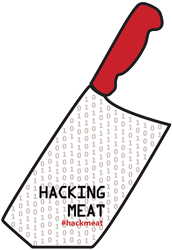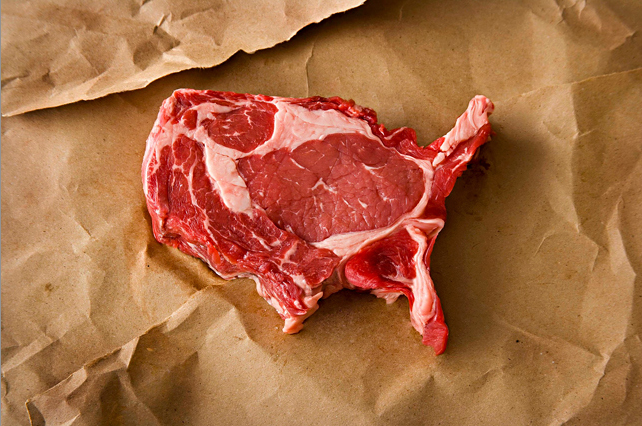
Food+Tech Connect and GRACE Communications Foundation present Hacking Meat, an online conversation exploring how information and technology can be used to hack (or reimagine) a more sustainable, profitable and healthy future for meat. Join the conversation and share your ideas or product requests in the comments, on Twitter using #hackmeat, Facebook , Tumblr or at the Hack//MeatSilicon Valley happening June 21-23 in Palo Alto.
Guest Post by Marilyn Noble of the American Grassfed Association
All meat producers face a large set of issues when it comes to raising livestock. Weather, drought, feed prices, herd health and regulatory compliance are all present challenges. But sustainable ranchers and farmers, unlike their commodity system brethren who enjoy a built-in market for their products, are faced with finding processing facilities, storage and distribution, as well as connecting their products to end-users in the marketplace through farmers markets, ecommerce, CSAs and other forms of direct sales. In addition, many of them spend time, money and effort to earn organic certification or third-party certifications through American Grassfed Association, Animal Welfare Approved, and others so they can demonstrate their commitment to creating products healthy for animals, consumers, the planet, and local economies.
On the other side of the equation are the chefs and consumers who want to put clean, healthy, humane, local, antibiotic- and hormone-free meat on their tables, but are faced with a confusing array of options. Large players in the commodity system slap labels with pretty pastoral scenes and meaningless, unverified claims – pastured, free-range, grass-finished, natural — on their packages of feedlot and confinement produced meat. While a busy parent may think that package of grocery store ground beef fits the ideal of ethically produced, healthy meat because the label looks good and the price says so, in reality, it may contain product from hundreds of animals from Uruguay, Australia, Canada, Mexico, and the U.S., and is not much better than the house brand package in the next case costing two dollars less a pound.
So how can technology help create a sustainable meat production system?
What if we created a network of regional and local meat hubs that connect producers to processors, distributors, institutional buyers, chefs, and consumers? This is a complex and challenging task, but it’s one way many small farmers and ranchers would be able to get their products to market in an efficient and competitive manner.
A meat hub could use technology to allow farmers to schedule processing times and share time with other small producers, making it more feasible to build small processing plants, thus creating more capacity. It could allow for inventory control, order processing, storage and shipping. When a chef wants to buy 100 pounds of hanger steak, there would no longer be an issue about what to do with the rest of the carcasses, because other buyers would be waiting for other cuts. Individual producers would no longer have to deal with large amounts of trim and the resulting ground beef, and consumers could find local, sustainable meats in their grocery stores. In short, appropriate technology on a local and/or regional level would provide to producers and consumers the advantages of the commodity meat system, but without the feedlots, inhumane slaughter houses, health risks, and environmental damage.
Much of this technology currently exists, but it’s designed for the industrial meat system. The software is expensive and time consuming to learn, both barriers to entry for small farms and processors. Simple, cost-effective and elegant technology solutions would help build a successful, thriving alternative to the current meat production system.
The demand exists for sustainably produced meats, and the number of farmers and ranchers making the switch to more sustainable production methods is growing. Now we just need to create efficient, cost-effective, regional and local supply chains, and the meat industry will see dramatic change.
The views expressed here are solely those of the author, and do not reflect the views of Food+Tech Connect.
How can regional “meat hubs” help scale the sustainable meat industry? Share your thoughts in the comments below, on Twitter using #hackmeat,on Facebook or at the Hack//Meat SV hackathon happening at The Stanford d.school in Palo Alto, June 21-23.
____________________
 Marilyn Noble is the communications director for the American Grassfed Association, an organization supporting grassfed ruminant production in the United States. AGA offers the only third-party grassfed certification program in the world. Marilyn is committed to supporting American family farmers who raise their animals on pasture without confinement, added hormones and antibiotics. She also educates consumers about the benefits of grassfed production – for animals, for the environment, for rural communities, and for families.
Marilyn Noble is the communications director for the American Grassfed Association, an organization supporting grassfed ruminant production in the United States. AGA offers the only third-party grassfed certification program in the world. Marilyn is committed to supporting American family farmers who raise their animals on pasture without confinement, added hormones and antibiotics. She also educates consumers about the benefits of grassfed production – for animals, for the environment, for rural communities, and for families.
In addition to her work with AGA, Marilyn has published three best-selling cookbooks and speaks and writes about sustainable agriculture. She is also the board chair for Slow Food Denver and the co-chair of the Rocky Mountain/Southwest Regional Ark of Taste Committee for Slow Food USA. She is a passionate advocate for a healthy, sustainable food system.
Photo Courtesy: Men’s Gear



